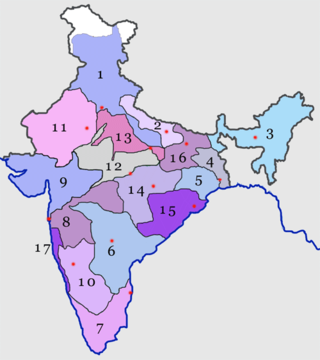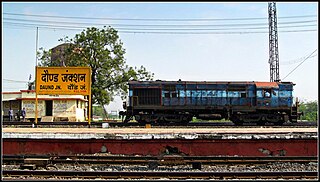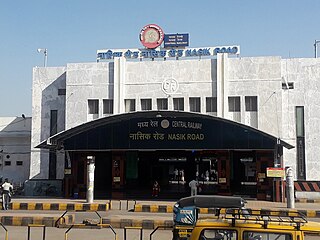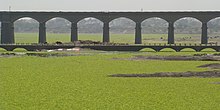
Central Railway is one of the 19 zones of Indian Railways. Its headquarters are located at Mumbai. It has the distinction of operating the first passenger railway line in India, which opened from Mumbai to Thane on 16 April 1853.

Manmad ( [mənmaːɖ]) is a town in Nashik district in Maharashtra, India. It is the third largest city in Nashik district, with a population of approximately 80,000. Geographically, the town lies within Nandgaon Tehsil in Nashik District. Though it has a larger area and population than most Tehsils in the district, it does not have a Tehsil office.

Pune district is a district in Western Maharashtra with Administrative Headquarters in Pune city. Pune district is the most populous district in the Indian state of Maharashtra. It is one of the most industrialised districts in India.
Indapur is a town and a municipal council in Pune district in the Indian state of Maharashtra. Indapur is known for Jahagir of Chhatrapati Shivaji Maharaj's father and grandfather. Chhatrapati Shivaji Maharaj's grandfather Malojiraje died in battle in Indapur.
Sangole or (Sangola) is a city with a municipal council in Solapur district in the Indian state of Maharashtra. It is situated near Holy city Pandharpur. It is located at the intersection of state highways SH-161, SH-3, and SH-71.
Shirur is an administrative subdivision of the Pune district in the Indian state of Maharashtra. It is located on the eastern boundary of the district, on the banks of the Ghod River. The town is also called Ghodnadi to distinguish it from other locations that have the same name. Ghodnadi in Marathi Language means Ghod River.

Shrivardhan is a subdistrict/upazila/tehsil, city, and local governing body in the Raigad district of the Indian state of Maharashtra. It is renowned as the birthplace of Balaji Vishwanath, the first Peshwa (1713–1720) and father of Bajirao I, who held the position of Deshmukh in the town. It has developed into a seaside resort, along with the nearby town of Harihareshwar, which also has a Shiva temple. Located on a peninsula, the town itself boasts many beaches, in addition to proximity to numerous other beach destinations such as Diveagar Beach and Kondivali Beach. People from across Maharashtra come to Shrivardhan and the nearby beaches all year round.
Tasgaon is a city in Maharashtra and Taluka in Sangli district in the Indian state of Maharashtra. Tasgaon city is developing city in Maharashtra. Tasgaon was given as Jahagir to Parshuram Bhau Tasgaonkar by Narayanrao Ballal Peshwa in 1774. Tasgaon Sansthan was lapsed by British during ruling of Shrimant Ganpatrao Tasgaonkar.
Saswad is a municipal council located on South-Eastern corridor of Pune district of the Indian state of Maharashtra. Saswad is situated on the banks of the Karha River. Saswad is about 31 km from Pune-Central Station.

Daund taluka is a taluka or subdivision of Pune district of the state of Maharashtra in India. The town of Daund is the only major urban area in this predominantly rural area. Daund railway station is a major railway junction. All southern railways are connected to this route, and also divided the Nagar railway to north Indian railway, like Delhi, Solapur division, Daund junction and then joined to the Pune district junction. To reach the Siddhi Vinayak Siddhatek Ganpati temple, one has to travel 14 km to Daund by road.
Pune railway division is one of the five railway divisions under the jurisdiction of Central Railway zone of the Indian Railways. It has its headquarters located at Pune in the Indian state of Maharashtra state. The other railway divisions are Mumbai CSMT, Nagpur, Solapur and Bhusawal. There are 71 railway stations in Pune railway division.

Daund Junction railway station is a railway junction station on the Mumbai–Chennai route of Indian Railways located in Pune district, Maharashtra, India. The Daund–Manmad line and the Daund–Baramati branch line start from here. Daund is a major freight redistribution hub.

The 11077 / 11078 Jhelum Express is a daily train on the Indian Railways. It runs from Pune, the cultural capital of Maharashtra, to Jammu Tawi, the winter capital of Jammu and Kashmir, in North India.

The Bhusawal–Kalyan section is part of the Howrah–Nagpur–Mumbai line and Howrah–Prayagraj–Mumbai line. It connects Bhusawal and Kalyan both in the Indian state of Maharashtra. One of the branch lines, Jalgaon–Surat line, runs partly in Gujarat.

Dadar–Solapur section is part of the Mumbai–Chennai line. It connects Dadar and Solapur both in the Indian state of Maharashtra.

Solapur railway station is located in Solapur district in the Indian state of Maharashtra and serves Solapur city and the industrial belt around it. It is headquarters of Solapur Railway Division and a part of Central Railway zone.
Yevat railway station is a suburban railway station in Pune district, Maharashtra. Its code is YT. It serves Yevat, a suburban area of the city. The station consists of two platforms. The platforms are connect by a sturdy foot-over-bridge. It has basic facilities, however it is scenic. It serves as the closest railway station to visit the beautiful Hindu temple of [[Bhuleshwar|Bhuleshwar]] dedicated to Lord Shiva.

Parli Vaijnath railway station is a railway station in Beed district in the Indian state of Maharashtra. It serves Parli Vaijnath city.
National Highway 160, commonly referred to as NH 160 is a national highway in India. It is a spur road of National Highway 60. NH-160 traverses the states of Maharashtra and Karnataka in India.
Daund Cord Line railway station is a railway station on bypass line joining Mumbai–Chennai line and Daund–Manmad branch line, located in Pune district, Maharashtra, India. It is also a junction station, although it is not named so.














